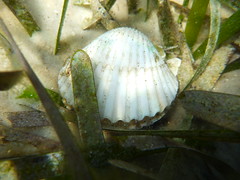A listing of the animals seen in the slideshow is at the end of this post.
 March is Seagrass Awareness Month, so it seems a fitting time to share some photos we took last fall. Seagrass beds are an under-appreciated habitat; they’re very productive and are more important than meets the eye (here I admit that neither seagrass beds or salt marshes seemed all that interesting to me until I actually went into them and took a closer look). Here are a few quick facts:
March is Seagrass Awareness Month, so it seems a fitting time to share some photos we took last fall. Seagrass beds are an under-appreciated habitat; they’re very productive and are more important than meets the eye (here I admit that neither seagrass beds or salt marshes seemed all that interesting to me until I actually went into them and took a closer look). Here are a few quick facts:
- Approximately 85% of commercial and recreationally fished species in Florida spend some time in a seagrass bed.
- Of the 60 or so seagrass species, turtlegrass (Thalassia testudinum) is the dominant in Florida- it’s the species of grass in the slideshow above.
- Seagrass meadows absorb 10-15% of the carbon absorbed by the ocean, which overall absorbs about 25% of global carbon emissions.
- Like salt marshes, seagrass beds slow waves and accrue sediment. The wave absorption protects shorelines from being battered and the sediment filtered from the water helps clean it.
- As sited earlier by Randall, a recent study has shown that 58% of seagrass habitats are in decline. If you look at all of the services provided by these habitats, you can see that this is cause for concern.
We should have a video on seagrass beds soon, as part of a new endeavor we are undertaking (stay tuned). In the meantime, I refer you back to Randall’s post on seagrass beds and epiphytic algae, and her post (with a video hosted by graduate student Emily Field) on Emily’s study of seagrass wrack, the blades of grass that slough off and impact other systems such as salt marshes. For more information Seagrass Awareness Month, visit the Florida Department of Environmental Protection web site.
The animals in the slideshow above are, in order (and excluding fish):
- Bay Scallop (4th pic)
- Sea Star (5th and 6th pics)
- Spider Crab (8th and 9th pics)
- Crown Conch (10th pic)
- Lightning Whelk egg case (11th pic- these are similar to crown conch egg cases)
- Sea Urchin (14th pic)
- Horse Conch (15th pic)
We will have a Meet the Species page for North Florida Seagrass Beds up soon.

